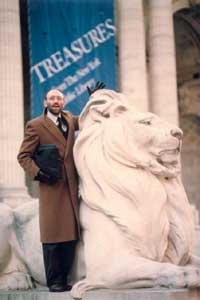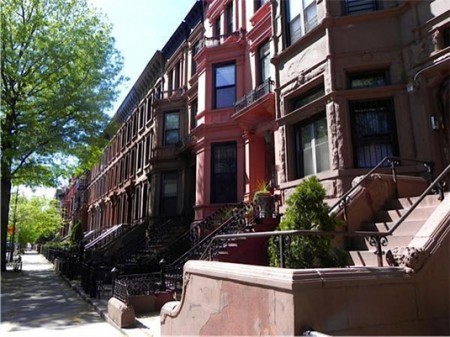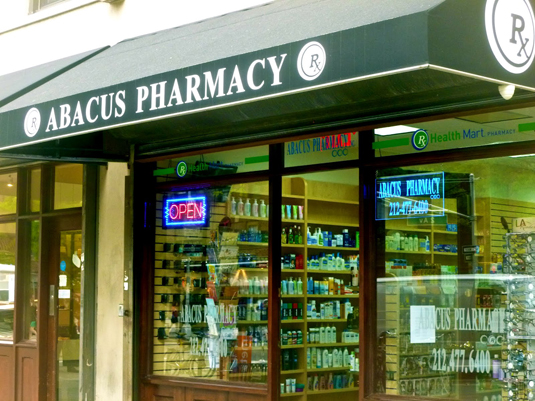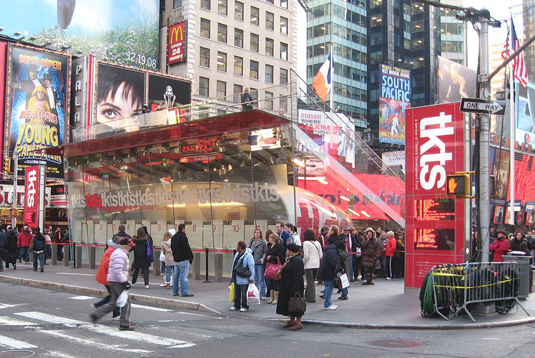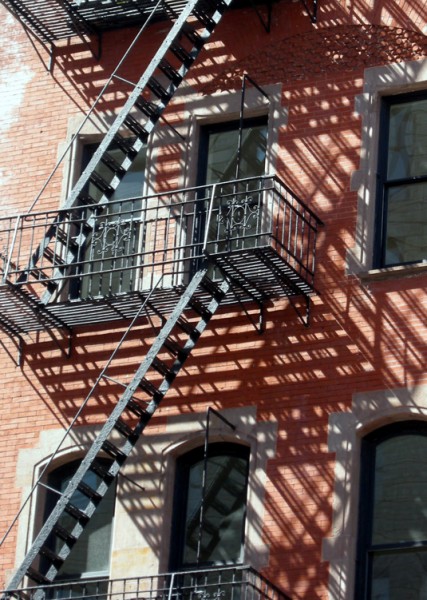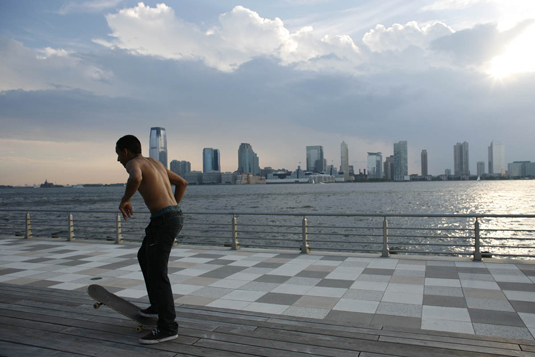
September 27, 2012
Q&A: OHNY’s Barry Lewis on New York CIty
Rockefeller CenterWhen I found out that Barry Lewis joined the Open House New York 10th Anniversary Advisory Council, I was eager to get him to talk about his favorite city. His answers to questions about local lore, architecture, neighborhoods, money, people—everything New York—will amuse, entertain, and enlighten one and all. I, for one, am grateful to […]
Rockefeller Center
When I found out that Barry Lewis joined the Open House New York 10th Anniversary Advisory Council, I was eager to get him to talk about his favorite city. His answers to questions about local lore, architecture, neighborhoods, money, people—everything New York—will amuse, entertain, and enlighten one and all. I, for one, am grateful to have someone of Barry’s commitment and enthusiasm on the New York scene. On the eve of OHNY (October 6th and 7th), here is what our very own New York mavin has to say about his metropolis. Dig in and enjoy!
Photo courtesy Dianne Arndt
Susan S. Szenasy: If there is one thing you could tell a friend from abroad about New York City, as it relates to the design (or lack of it) you encounter here every day, what would that be? Please explain.
Barry Lewis: Money. It’s all about making money. It’s why the Dutch founded us. New York’s architecture is pure speculation: build it, rent it, sell it, tear it down, and build something bigger. So New York’s buildings are usually safely commercial in design: they want to be noticed (so they’ll rent) but don’t think them too weird. And if they’re “artsy”, as in the starchitect buildings of today—it’s only to bring in more $ per sq. ft. However, squoosh together all this capitalist striving on a narrow little island set off by frame-setting rivers, and what do you have? One of the most thrilling skylines in the world.
SSS: I’d like to dip into your extensive knowledge of NYC history. Which is your very favorite period in the making of our city? In that period, pick a building or a place or neighborhood that exemplifies the ethos of its time and explain how it does that.
BL: The Beaux-Arts era at the turn of the 20th century was New York’s coming of age as a world capital, at a time when we Americans loved cities and wanted to make them not only beautiful but democratic. So within a 25 year time span we have everything from the 42nd Library and the Metropolitan Museum to small gems like the Frick and the Morgan; we have urbane and brilliantly planned transportation complexes principally Grand Central and Penn Station; we have the beginning of apartment house living on the Upper West Side and soon Park Avenue and skyscraper office buildings sprouting around Wall Street and its offshoot, Madison Square. Downtown—Wall Street–was the center of the financial universe and romantic towers like the Singer and the Woolworth buildings announced the city’s ascendancy. Yes, the Lower East Side and Harlem were tightly packed slums but in the next generation (as we know in hindsight) would come the Harlem Renaissance uptown and the subway suburbs from the Bronx to Brooklyn where 1920s strivers could find a middle class lifestyle and got themselves out of the slums.
Barry Lewis outside the New York Public Library, Photo courtesy NY Magazine 1985
The Beaux-Arts and Art Deco eras (the 1920s and 30s) were the last eras when we Americans actually liked cities. Only in the last dozen years or so has the American middle class re-discovered “city” life. Since we spent the 50 years in between doing everything possible to destroy our great urban centers, it’s amazing our American cities all haven’t gone the way of Detroit.
SSS: You must have hundreds of great places you like to visit in NYC; can you list 10 here? And give some detailed historic information about one.
BL: 10 places + annotations? In New York City? That’s probably a book. Here goes, off the top of my head:
1. Rockefeller Center (pictures above) the best skyscraper complex I’ve ever seen.
I grew up with it, loved it then, love it even more today. It marries the skyscraper with the traditional city brilliantly weaving Le Corbu’s “slabs”, Beaux-Arts ideas of city planning, German Expressionist visions of cathedral-like symbolism, and steel cage construction whose flexibility and strength give us an underground shop-lined “street” system, among the world’s first extensively covered shopping malls. All this was wrapped around a new Subway line (under Sixth Avenue) making the entire project “green” in conception. Plus it gave us Radio City Music Hall where I had the best time as a kid in the 50s seeing first-run movies on that one-of-a-kind screen with the Rockettes “thrown in” between the movies, newsreel, cartoon, and film short all for the 25 cent price of admission.
2. Flushing Meadow Park/Prospect Park Parade Grounds/Van Cortlandt Park—on the weekends.
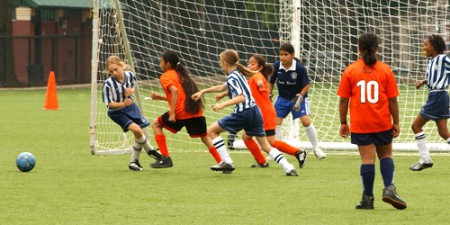
Prospect Park Parade Grounds
Every ethnic group in the world is playing some kind of game in one of these venues. Yes, they’re all in Central Park too, but our immigrant and native population live in the outer boroughs (you think they can afford Manhattan?!) and that’s where they and their audience play their games, eat from their food vendors and root for their team.
3. Hamilton Terrace in Hamilton Heights; Hancock Street off Marcy Avenue and Stuyvesant Avenue off Hancock in Bedford-Stuyvesant.
Hancock Street, Bedford-Stuyvesant, Brooklyn, NY
Nineteenth century New York brownstone neighborhoods at their best; and almost all black middle class homeowners—for generations. Atlanta knows it has a large black middle class but New Yorkers have only a fuzzy notion that they exist. It was the black population that inherited these neighborhoods from their original white owners anywhere between the 1930s and the 1950s, and they saved these brownstone districts from post WW II decay. Theirs is a very tight knit world of fraternal organizations, social societies etc. A fascinating world sometimes revealed in novels and memoirs but inextricably bound with the bricks and the brownstones of their homes.
4. Jackson Heights: 74th Street (Sari Alley); 82nd Street/Roosevelt to 37th Avenue; Roosevelt Avenue (under the el) between 74th and 82nd Streets.
Latino New York mixed in with Asian New York, one moment we pass a vegetarian doshi place and the next moment it’s seviche. Jackson Heights’ original apartment buildings were part of a planned neighborhood brilliantly conceived by a hard-boiled developer named Edward MacDougall. He gave us a beautiful ‘main street’, 82nd Street off the “el”, and created the garden apartment house with the interiors of the blocks landscaped as mini-Central Parks–a wonderful template for urban apartment houses from the Bronx to Brooklyn, from New York to San Francisco. Those original interior gardens still exist but the Community Center (a converted early 19th century country house), private golf course, and tennis courts are gone. What we have today is one of the most ethnically diverse zipcodes in the United States. And to think: the original Jackson Heights development was “restricted”. If he could come back today, what would Eddie MacDougall think?
5. West 79th Street / Henry Hudson Parkway / 79th Street Boat Basin Traffic Interchange
Created by Robert Moses in the 1930s as part of his Henry Hudson Parkway scheme and the re-design of Riverside Park, it shows us that the later Interstate Highway System had it wrong: You don’t have to mercilessly destroy a city to build a highway. Ok, there’s always the argument the Parkway shouldn’t cut us off from the river; but from the 1830s the Hudson River Railroad cut us off even more crudely. Moses moved the railroad up against the cliffs, decked it over with a much used promenade and smacked athletic courts up against the decking on the river side. At 79th Street he built one of the most civilized traffic interchanges that meshes with the 79th Street Boat Basin and today houses the popular and seasonal Boat Basin Café.
Other innovative stretches of New York City highway include the multi-decking of the East River Drive under both the UN/Beekman Place complex and Gracie Mansion and the brilliant triple decking that produced the Brooklyn Heights Promenade. Why couldn’t the Interstate Highway planners be equally as resourceful a generation later? Instead they sliced and diced our cities driving even more people to the suburbs—on the very highways that destroyed the fine old city neighborhoods they were leaving.
6. Our local pharmacists, etc..
Our neighborhood mom & pops have been eviscerated but compared to Wal-Mart-ed America, New York still has a surprising number of private retail business from local hardware stores to private pharmacies. We have enough of a density of population that we can support these mom & pops because we don’t have cars (or its too difficult to use them) and the local places give us special services like home delivery, and knowing what brand we like, and fronting us an Rx until we get our paycheck. It’s not just their existence, but who runs them, that’s so New York.
When on a tour I did about a year ago a middle aged woman politely asked me what I thought about the mosque going up near the World Trade Center, I told her that if there were no Muslims in New York City, I wouldn’t have my local pharmacist, my notary public, the guys at the corner superette, the guys at the 7-Eleven a few blocks further down the street, and half the taxi drivers in New York City—and that’s only as starters. Small retail businesses in New York City were once run by Jews and Italians. Then came the Koreans. Now it’s the Middle Easterners, the South Asians, Silk Road Republics, and East Asians with a few Latinos in the mix. But that’s New York. It was the gateway city for my peddler grandfather who came from the deepest part of Russia, and it’s the gateway for the newcomers today. Walk into a newsstand /magazine store and it’s probably a south Asian or a Palestinian, an Israeli or an Azerbajanian who’s running it. It’s still the American dream and it’s why people come here in the first place.
And it still gives a place around the corner we can walk to, to buy our stuff.
7. Asking directions from passengers on a public New York City bus….
The media tells us that New Yorkers are rude or stand-offish. That’s because we’re all in a rush and need to get someplace. But ask for directions on a partly filled bus (when it’s too crowded, people button up) and suddenly there’s a roundtable discussion over what is the best way to get to wherever you need to go with the fewest transfers. And if it involves the Subway, I bet someone on the bus can tell you whether you need to be at the front end of the platform or the back for your exit. This doesn’t work on the subway and it doesn’t work on the street, but a slow moving, partly packed bus is like a temporary “village” on wheels. Well, it usually doesn’t work that way, but when an out-of-towner who doesn’t know any better, pipes up and asks directions suddenly everyone within hearing distance becomes your own New York “yenta”.
8. Times Square
Since it was rebuilt at the turn of this century, following the Disney Co’s exquisite renovation of the New Amstedam Theater (Mary Poppins is playing there now), New Yorkers love to bitch and whine about Times Square. Well, get over it. I grew up in this city, and it’s the first time in half a century that everyone goes to Times Square.
TKTS Ticket Booth
I was there in the 1970s when the first-run movie houses, at the 10 p.m. weekday show, had almost all homeboys or homeboys with their dates as the audience. We whites never had a problem. Ever. But the audience talked to the movie and you just had to get used to that. Now Times Square is pulling in everyone: young, old, outer borough, Jersey, uptown, downtown, tourists. In fact, it’s filled with tourists, which is why I love it. Tourists and gaudy signs that are the modern equivalent of the 1950s-era Camels fellow blowing smoke rings and Little Lulu pulling at her Kleenex. The tourists are ecstatic. They’re in a place they’ve seen in movies and TV all their lives. And now they’re here. The recent re-do of the TKTS ticket booth at the north end of the square, with its red lit staircase “to the stars” is the perfect bleachers for perusing the scene—if you can find any space. Then with all these happy foreigners sitting at the outdoor café seats (in Times Square? And they’re not bolted to the ground?), you can tell when a New Yorker comes thru: they’re depressed, kvetching, and dressed in black. And they want to know why all “these people” are crowding “my city”. If I want crowds I go to Times Square. Because they’re mostly from out-of-town, they are the best crowd in-town to people watch and enjoy.
9. The New York City Fire Escape
New York Fire Escape
Part of the city that’s disappearing is our New York fire escapes. Created by legal necessity, and looking it—though some have interesting designs—our fire escapes in my youth were part porch, part barbecue, part summer bedroom (unless you rolled over the wrong way in the middle of the night), part gossip venue. As kids we threw water balloons down from the fire escape on kids we didn’t like. As a 20-something I remember locking myself out of my walk-up apartment, on New Year’s Eve, with only a towel on (I had gone to throw the garbage out and forget my door was self-locking), had to go upstairs to the equally young woman tenant above me (we were all young in that building) and climb through her window, down the fire escape from the 5th to the 4th floor, in a light snow, barefoot, and afraid of heights. But via my fire escape and my open window, I got back in my apartment. You just don’t have those kinds of adventures with current fire code stairwells.
10. The new urbanism of Forest Hills Gardens, Douglaston, Kew Gardens, Sunnyside Gardens, and Riverdale/Fieldston.
Forest Hills Gardens
People think New York is all apartment houses and Brooklyn brownstones. Well yes that’s true, but that’s only part of the story. It’s also the home of the best American templates for urban/suburban planning the 20th century produced. Practicing today what’s called the “new urbanism”, known as “garden suburbs” back then, this era from the 1900s to the 1930s produced well planned residential neighborhoods, built around rapid transit stops and giving their city dwellers the choice of all kinds of rus in urbe housing, with parks, greenways, perhaps sports facilities, and village-like shopping districts hugging the train station. New Yorkers could choose suburban type free-standing houses—Douglaston is a knock-out in both house design and it’s site overlooking Long Island Sound; or more urban rowhouses and apartment buildings–Kew Gardens has both as well as single family detached houses and a “main street” bridging the railroad tracks, Ponte Vecchio-style. Excellent city planning and the weaving of parks and gardens into a basically urban neighborhood—Forest Hills Gardens is probably one of the most well known planned neighborhoods in the country. We also have Sunnyside Gardens with its brilliant Clarence Stein/Henry Wright design, giving every block their own central commons, the Jackson Heights idea done on a working class budget.
Plus, these developers, planners, and architects respected the landscape. In Douglaston the spectacular beachy shoreline plus the Douglaston Club which is the old Douglas mansion are forever protected, owned communally by the homeowners in Douglaston Manor. In Forest Hills Gardens, the Olmsted brothers (sons of the Olmsted of Central Park fame) did a brilliant job of organically laying out streets, commons and small parks while architect Grosvenor Atterbury used his eclectic architectural vocabulary for a visually comfortable environment—Station Square is a brilliant evocation of European town centers for modern Yankees—yet innovative: some of America’s earliest all concrete houses went up in “the Gardens” in 1919.
All these neighborhoods provided (and still do) a walk-to-transit, walk-to-shopping, walk-to-friends-and-neighbors lifestyle. If America followed these examples after World War II we all wouldn’t be stuck in traffic L.A. freeway-style, in our 4-ton SUV “tanks” isolated behind our all black glass, getting angry, and committing road rage.
SSS: What can visitors learn about New Yorkers from our public spaces? Narrow your choice down to one type of public space. How did these places describe us once, how do they describe us now?
BL: For years, the center of Herald Square was a filthy mess, a Jackson Pollack of pigeon droppings and the homeless dozing while junkies were sleeping it off. It reflected the city of the 1970s, 80s and 90s, with high crime rates, the defection of the population to the suburbs, and the financial straits of municipal government all making the city’s public spaces almost scary. That has all changed. A richer population, booming tourism, and a population growth that tops the local suburbs, New York has revolutionized its public spaces in the last 20 years. The change began with Battery Park City in the 1980s where a brilliantly designed promenade and its adjoining small vest pocket parks created public spaces like I knew in Paris: outdoor living rooms where people felt relaxed and comfortable. Now we have not only Hudson River Park, the High Line, Brooklyn Bridge Park, and the new Riverside Park South all of which are making the once industrial riverfronts our new “Central Parks”, but we also are turning garbage strewn, asphalted traffic interchanges into magnificent public spaces for sports, exercising or just plain sitting (with of course smartphone or iPad in hand). Look at the western end of Canal Street, once a gridlock of traffic: the traffic is still there but the traffic islands in between have become parks and playing fields as attractive as anything I’ve seen abroad. At West 24th Street, where Eleventh Ave merges with the West Side Highway, a former square block of nothing has been transformed into a handsome playing field and across the “highway” the newer sections of Hudson River Park give us a small “Sheep Meadow”, a pier for kids with a carousel, a terrific skate park for rollerbladers and co., and the very popular seasonal Frying Pan restaurant at Pier 66. Right next door, kayakers trek out into the river, an astonishing site for someone who as a kid was warned to never touch the water of the Hudson River, unless I wanted a tetanus shot at the local ER. No less astonishing is seeing Herald Square’s café tables filled with people enjoying the outdoor venue, its cleverly designed perimeter landscaping brilliantly filtering out the crush of the traffic. Movable café tables and chairs remind me of Paris (where I lived years ago), their vulnerability to theft making them out-of the-question for a good 40 years of New York’s history. But even when I was a kid, when the crime was low and the city basically safe, our public spaces never were as brilliantly conceived and designed, never as user friendly, never as ‘civilized’ as they are today.
SSS: Does the hustle and bustle ever get to you? I don’t see evidence of this in your enthusiastic TV tours. But if you need a moment of respite, where do you camp out?
BL: Central Park—on the weekdays during the day. There’s really no one there. It’s a whole different park from what happens on the weekends. For an even more solitary experience, Flushing Meadow is practically empty during the weekdays—but I never feel unsafe. And Hudson River Park, during the weekdays, is never really crowded. Even on the weekends, if the High Line is too packed (crowds make me claustrophobic) I detour over to Hudson River Park and there’s always just enough people to make it interesting, but generally not enough to “invade your space”. And with the river views, and someplace always to plop down, it’s just superb.
Pier 25, Hudson River Park




